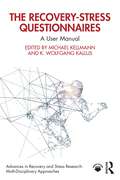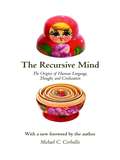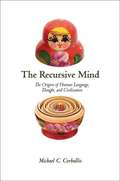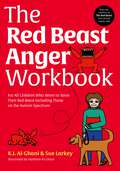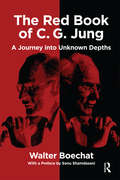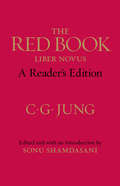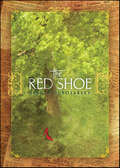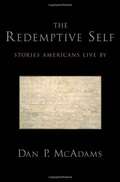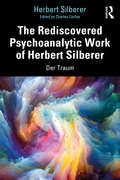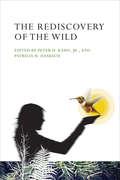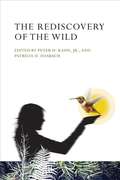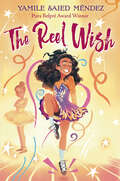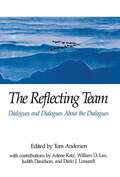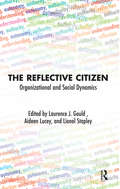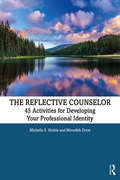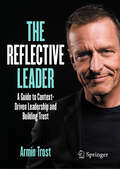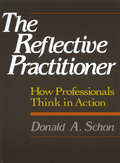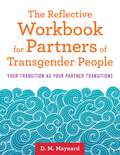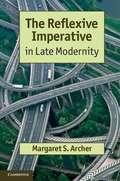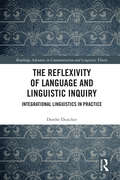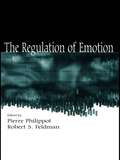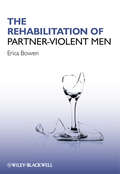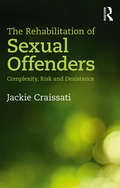- Table View
- List View
The Recovery-Stress Questionnaires: A User Manual (Advances in Recovery and Stress Research)
by Michael Kellmann K. Wolfgang KallusThe Recovery-Stress Questionnaires (RESTQs) identifies the current recovery-stress states and provides a complete picture of the actual extent of stress and recovery. Written to support those using the RESTQ, this manual offers advice on scope and application, facets of stress and recovery, versions and scoring, interpretation of results, and reliability and validity for each of the five forms of the questionnaire.The questionnaire is based on the hypothesis that an accumulation of stress in different areas of life, with insufficient opportunity for recovery, leads to a critical psychophysiological state. The RESTQ measures the frequency of current stress symptoms along with the frequency of recovery-associated activities to offer a differentiated picture of the current recovery-stress state. There are five forms of the RESTQ: a general version (RESTQ-Basic) with seven stress scales and five recovery scales is the foundation for the specific versions for athletes (RESTQ-Sport), for coaches (RESTQ-Coach), for children and adolescents (RESTQ-CA), and for the work context (RESTQ-Work). All versions take a modular structure and contain scales measuring specific aspects of stress and recovery in their field. These scales provide valuable information immediately on areas where improvement is needed in stress and recovery research across a range of applied settings.Drawing on experiences and scientific findings from sport to make them usable for an expanded understanding of recovery in the fields of health, work, and other related areas, this manual is written for the scientific community, applied psychologists and health scientists, and interested readers.
The Recursive Mind
by Michael C. CorballisThe Recursive Mind challenges the commonly held notion that language is what makes us uniquely human. In this compelling book, Michael Corballis argues that what distinguishes us in the animal kingdom is our capacity for recursion: the ability to embed our thoughts within other thoughts. "I think, therefore I am," is an example of recursive thought, because the thinker has inserted himself into his thought. Recursion enables us to conceive of our own minds and the minds of others. It also gives us the power of mental "time travel"--the ability to insert past experiences, or imagined future ones, into present consciousness. Drawing on neuroscience, psychology, animal behavior, anthropology, and archaeology, Corballis demonstrates how these recursive structures led to the emergence of language and speech, which ultimately enabled us to share our thoughts, plan with others, and reshape our environment to better reflect our creative imaginations. He shows how the recursive mind was critical to survival in the harsh conditions of the Pleistocene epoch, and how it evolved to foster social cohesion. He traces how language itself adapted to recursive thinking, first through manual gestures, then later, with the emergence of Homo sapiens, vocally. Toolmaking and manufacture arose, and the application of recursive principles to these activities in turn led to the complexities of human civilization, the extinction of fellow large-brained hominins like the Neandertals, and our species' supremacy over the physical world.Some images inside the book are unavailable due to digital copyright restrictions.
The Recursive Mind: The Origins of Human Language, Thought, and Civilization
by Michael C. CorballisThe Recursive Mind challenges the commonly held notion that language is what makes us uniquely human. In this compelling book, Michael Corballis argues that what distinguishes us in the animal kingdom is our capacity for recursion: the ability to embed our thoughts within other thoughts. "I think, therefore I am," is an example of recursive thought, because the thinker has inserted himself into his thought. Recursion enables us to conceive of our own minds and the minds of others. It also gives us the power of mental "time travel"--the ability to insert past experiences, or imagined future ones, into present consciousness.Drawing on neuroscience, psychology, animal behavior, anthropology, and archaeology, Corballis demonstrates how these recursive structures led to the emergence of language and speech, which ultimately enabled us to share our thoughts, plan with others, and reshape our environment to better reflect our creative imaginations. He shows how the recursive mind was critical to survival in the harsh conditions of the Pleistocene epoch, and how it evolved to foster social cohesion. He traces how language itself adapted to recursive thinking, first through manual gestures, then later, with the emergence of Homo sapiens, vocally. Toolmaking and manufacture arose, and the application of recursive principles to these activities in turn led to the complexities of human civilization, the extinction of fellow large-brained hominins like the Neandertals, and our species' supremacy over the physical world.
The Red Beast Anger Workbook: For All Children Who Want to Tame Their Red Beast Including Those on the Autism Spectrum
by Kay Al-Ghani Sue LarkeyThis illustrated and interactive workbook will help children find ways to calm their Red Beast and learn how to prevent it from waking in the first place. Full of practical activities and illustrated examples, it supports the development of emotional and sensory regulation and provides coping mechanisms for children who experience intense emotional flooding or meltdowns as well.The workbook includes a helpful introduction for adults on the science of self-regulation, clear guidance on how to pace the learning and a wide range of activities such as scenarios to help children explore their anger, anger management plans, and exercises that encourage interoceptive awareness. It also addresses common causes of anger including perfectionism, winning and losing and discusses the importance of a positive attitude and using kind words in a child-friendly way.Join Danni and his friends and family as they explore the challenges they face from the Red Beast and how they overcome them.
The Red Book of C.G. Jung: A Journey into Unknown Depths
by Walter BoechatThis book focuses on some of the main aspects and importance of The Red Book for the understanding of the work of C.G. Jung. It sheds light on the great mysteries of human nature and the new dimension uncovered by Jung and Freud: the universe of the unconscious and the possible ways to approach it.
The Red Book: A Reader's Edition
by C. G. Jung Sonu Shamdasani John Peck Mark KyburzA portable edition of the famous Red Book text and essay. The Red Book, published to wide acclaim in 2009, contains the nucleus of C. G. Jung's later works. It was here that he developed his principal theories of the archetypes, the collective unconscious, and the process of individuation that would transform psychotherapy from treatment of the sick into a means for the higher development of the personality. As Sara Corbett wrote in the New York Times, "The creation of one of modern history's true visionaries, The Red Book is a singular work, outside of categorization. As an inquiry into what it means to be human, it transcends the history of psychoanalysis and underscores Jung's place among revolutionary thinkers like Marx, Orwell and, of course, Freud." The Red Book: A Reader's Edition features Sonu Shamdasani's introductory essay and the full translation of Jung's vital work in one volume.
The Red Book: Reflections on C.G. Jung's Liber Novus
by Thomas Kirsch George HogensonIn 2009, WW Norton published ‘The Red Book’, a book written by Jung in 1913-1914 but not previously published. Snippets of information about the likely contents of the Red Book had been in circulation for years, and there was much debate and eager anticipation of its publication within the Jungian field and the larger reading public. In 2010, a conference was held at the San Francisco Jungian Institute which brought together an international group of distinguished scholars in analytical psychology to explore and address critical contextual aspects of ‘The Red Book’ and to debate its importance for current and future Jungian theory and practice. The Red Book: Reflections on C.G. Jung’s Liber Novus is based on that conference, the individual papers have been thoroughly revised and updated for this book and address some of the important questions and issues that were raised at that conference in response to the presentation of these papers. As yet there has been very little published about ‘The Red Book’. The Red Book: Reflections on C.G. Jung’s Liber Novus will contribute to setting the agenda for further research, both scholarly and clinical, in response to Jung’s account of his experiences between 1913-1914, when arguably, the future course of his entire project was set in motion. This book will be essential reading for any Jungian interested in the importance of The Red Book, analytical psychologists, trainee analysts, those with an interest in the history of ideas and historians.
The Red Ribbon: A Memoir of Lightning and Rebuilding After Loss
by Nancy Freund BillsIn the summer of 1994, a freak lightning and thunder storm explodes on the southern coast of Maine, killing Nancy Bills’s husband and critically wounding her younger son. She promises her late husband that she will write their family’s story and bind it with a red ribbon of love and courage. In language alternately tender and gritty, The Red Ribbon documents the aftermath of Bills’s husband’s death. As a wife, she grieves and attempts to rebuild her life; as a mother, she strains to be the parent her young adult sons need. Then, one year later, she is faced with more loss—this time, the father whom she adores. After his death, other deaths, some anticipated and others unpredictable, follow. Meanwhile, the impending death of her aging mother is a particular challenge; Nancy struggles to be a good daughter, and on many visits to Montana, her home state, she tries to mend their painful history. Insightful, moving, and full of intelligence and humanity, The Red Ribbon is a story of surviving the many and often devastating lightning strikes of life, and a gift of compassion and wisdom for readers who are struggling with their own losses.
The Red Shoe
by Ursula DubosarskyFunny, tough-minded and tender, this is the story of Matilda and her two sisters growing up in Sydney, Australia, in the early 1950s. Their father is mentally unstable and largely absent, their mother is possibly in the thrall of his brother, and a headline-making Russian spy defection is taking place next door. Punctuated by the headlines of the times, The Red Shoe depicts how the large events of the world can impinge on ordinary lives. This is a novel to savor by one of Australia's most gifted writers for young people."Dubosarsky proves masterful in conjuring and connecting images." - Publishers Weekly
The Redemptive Self: Stories Americans Live By
by Dan P. McAdamsWho are we as Americans? What is our deep identity? How do we make a good life? Renowned psychologist Dan P. McAdams suggests that the key to American identity lies in the stories we live by. And the most powerful life story in America today is the story of redemption. On a broad societal scale and in our own private lives, we want first and foremost to transform our suffering into a positive emotional state, to move from pain and peril to redemption. American identity is the redemptive self. Based on 10 years of research on the life stories of especially caring and productive American adults, The Redemptive Self explores the psychological and cultural dynamics of the stories Americans tell to make sense of who they are. Among the most eloquent tellers of redemptive stories are those midlife adults who are especially committed to their careers, their families, and making a positive difference in the world. These highly "generative" men and women embrace the negative things that happen to them, for it is by transforming the bad into good that they are able to move forward in life and ultimately leave something positive behind. Unconsciously, they find inspiration and sustenance in the rich store of redemptive tales that American culture offers - from the autobiographies of Massachusetts Puritans, Benjamin Franklin, and escaped African-American slaves to the stories of upward mobility, recovery, fulfillment, and release that come to us today from Hollywood, 12-step programs, self-help experts, religious stories, political speeches, business gurus, and Oprah. But can all American lives find redemption? Some people seem unable to make their lives into redemptive tales. Instead, their stories show contaminated plots and vicious cycles. Moreover, might there be a dark side to the redemptive stories Americans love? While these stories can sustain a productive and caring approach to life, they can also suggest a peculiarly American kind of arrogance and self-righteousness. For all their strengths, redemptive stories sometimes fail, and sometimes suggest important failings in the way Americans see themselves and the world. The Redemptive Self encourages us to examine our lives and our stories in full, to apprehend both the good and the bad in the stories we live by. By doing so, we may fashion better stories and better lives for the future.
The Rediscovered Psychoanalytic Work of Herbert Silberer: Der Traum
by Herbert SilbererCharles Corliss presents, for the first time, the complete English translation of Herbert Silberer’s work on dreams, Der Traum: Einführung in die Traumpsychologie. Based on lectures delivered at the majestic Urania Star Observatory in Vienna in 1918, Der Traum was a wide-ranging, accessible introduction to the meaning of dreams, with examples from Silberer’s practice providing a rich source of illustration. One hundred years after the work was first published in Silberer’s native German, Corliss rescues his voice from obscurity and adds key supplementary information to place the work in context. The book begins with an introduction which surveys the range of Silberer’s contributions to psychoanalysis and sets out what is known of his life, before presenting the full original text. Presented in eight parts, each with preliminary remarks by Corliss, the book covers several topics including differing viewpoints on dreams, Silberer’s concept of the hypnagogic phenomenon, experimental dreams, and aspects of his own theory. Der Traum ends with a philosophical exploration of how dream content relates to the core moral fiber of our being, with the work as a whole reflecting Silberer’s optimistic, depth-oriented, and at times, almost mystical stance. Corliss concludes the book with a reflection on the rich, teleologically optimistic, and refreshingly panoramic value of Der Traum. This unique book will be of interest to analytical psychologists and Jungian psychotherapists in practice and training, as well as to academics and students of Jungian studies and the history of psychoanalysis, psychoanalytic studies, theology, philosophy, and the history of psychology.
The Rediscovery of the Wild
by Jr. Peter H. Kahn Patricia H. HasbachA compelling case for connecting with the wild, for our psychological and physical well-being and to flourish as a species. We often enjoy the benefits of connecting with nearby, domesticated nature—a city park, a backyard garden. But this book makes the provocative case for the necessity of connecting with wild nature—untamed, unmanaged, not encompassed, self-organizing, and unencumbered and unmediated by technological artifice. We can love the wild. We can fear it. We are strengthened and nurtured by it. As a species, we came of age in a natural world far wilder than today's, and much of the need for wildness still exists within us, body and mind. The Rediscovery of the Wild considers ways to engage with the wild, protect it, and recover it—for our psychological and physical well-being and to flourish as a species.The contributors offer a range of perspectives on the wild, discussing such topics as the evolutionary underpinnings of our need for the wild; the wild within, including the primal passions of sexuality and aggression; birding as a portal to wildness; children's fascination with wild animals; wildness and psychological healing; the shifting baseline of what we consider wild; and the true work of conservation.
The Rediscovery of the Wild
by Peter H. Kahn Patricia H. HasbachWe often enjoy the benefits of connecting with nearby, domesticated nature -- a city park, a backyard garden. But this book makes the provocative case for the necessity of connecting with wild nature -- untamed, unmanaged, not encompassed, self-organizing, and unencumbered and unmediated by technological artifice. We can love the wild. We can fear it. We are strengthened and nurtured by it. As a species, we came of age in a natural world far wilder than today's, and much of the need for wildness still exists within us, body and mind. T he Rediscovery of the Wild considers ways to engage with the wild, protect it, and recover it -- for our psychological and physical well-being and to flourish as a species. The contributors offer a range of perspectives on the wild, discussing such topics as the evolutionary underpinnings of our need for the wild; the wild within, including the primal passions of sexuality and aggression; birding as a portal to wildness; children's fascination with wild animals; wildness and psychological healing; the shifting baseline of what we consider wild; and the true work of conservation.The hardcover edition does not include a dust jacket.
The Reel Wish
by Yamile Saied MéndezAfter a panic attack prevents Florencia from performing as Clara in The Nutcracker and her best friend takes the lead, a new dance style helps her face her anxiety as well as a troubled friendship.Ballet is Florencia del Lago's entire world. After years of hard work, she is chosen as Clara in the winter production of The Nutcracker. Not only is she the youngest dancer to receive such an honor but also the first Latina. She's on track to be recruited by the best ballet companies.Unfortunately, she suffers a panic attack on opening night--on stage, in front of everyone. And then Selena, Florencia's best friend, steps right into the role to replace her. Just like that, Florencia's whole world falls apart--the ballet studio expels her, and her best friend turns on her, tormenting her on social media and in real life.But even though the one thing she was driven toward has come to an end, therapy and family support help Florencia open up to new experiences. She notices people at school she's never paid attention to before, and she even stumbles upon an Irish dance school and decides to give it a try. Can a new passion for Irish dance help Florencia find the joy of performing on the stage that she lost that fateful winter night?
The Reflecting Team: Dialogues and Dialogues About the Dialogues
by Tom AndersenWhat happens when the barriers between therapists and clients are removed, when they all participate in a dialogue about change, and when therapists and clients even trade places? As Lynn Hoffman says in her forward to this remarkable book, it "dramatically alters a family's position in relation to the professionals they have come to see." In the process, it changes the roles, rules, and expectations of therapy. Operating within the reflecting team format, professionals meet clients without preexisting hypotheses. Together they engage in a conversation that becomes a search for the not-yet-seen and the not-yet-thought-of, as well as for alternative understandings of what has been defined as problematic. As clients and therapists trade places and various members of the entire group participate in conversations, the possibilities for change open wide. This book describes the evolution of this radical strategy in Tromso, Norway, and its adaptation by various family therapists in the United States. It begins in Part I with a description of the settings in which the reflecting team developed and its history and evolution. Then basic concepts, practical considerations, and guidelines for practice are detailed. Part II contains Dialogues About the Dialogues, that is, reflections on the client-therapist-consultant-team dialogues that distinguish this innovative approach to therapy. As roles shift and various participants offer definitions of the problem and possible solutions, traditional ideas about the boundaries of a "case study" are shattered. Readers will find that this fluid, encompassing perspective stimulates their own thoughts about therapy, shaking them from outgrown assumptions. Since this approach is still evolving, the final chapter is, appropriately, a reflection on the changes that have taken place since the European edition of this book was published.
The Reflective Citizen: Organizational and Social Dynamics (The\reflective Citizen Ser.)
by Laurence J. GouldThis is the first in a "Reflective Citizen" series, the intention being to develop volumes from the various OPUS (An Organisation for Promoting Understanding of Society) activities which include Scientific Meetings, Workshops, Lectures, Debates and Conferences. The objective of OPUS is to promote and develop the study of conscious and unconscious organisational and societal dynamics through educational activities, research; consultancy and training; and, the publication and dissemination of these activities for the public benefit.
The Reflective Counselor: 45 Activities for Developing Your Professional Identity
by Michelle S. Hinkle Meredith DrewThis practical workbook contains 45 experiential and creative activities intentionally created to facilitate counselor professional identity development. Each reflective activity is designed for students and supervisees to learn more about counselor professional identity, as well as integrate their knowledge of counseling skills and content with personal attributes and experiences. Individual and group process questions and group follow-up activities make this an ideal workbook to supplement classes or group supervision. Upon completion of the workbook, students and supervisees will have a journal of their process in the beginning stages of counselor professional identity development. With chapters focusing on areas including counselor wellness, self-growth, personal and professional values, multicultural awareness, research and assessment, and more, The Reflective Counselor is an essential resource for counseling graduate students, supervisees, and new professionals alike.
The Reflective Leader: A Guide to Context-Driven Leadership and Building Trust
by Armin TrostEffective leadership requires a clear idea of leadership, which must be primarily guided by the specific conditions of their leadership context. Only the leader themselves is responsible for developing the right idea of leadership. Leaders who actively reflect on their context and their role are more likely to achieve success. By combining thoughtful self-awareness with intentional decision-making, they can move beyond relying solely on intuition and gut feelings. This approach fosters stronger, trust-based relationships between leaders and employees. This book not only provides theoretical foundations but also offers practical tools that have been proven effective in practice over many years. With the help of this book, managers will learn to understand their leadership context and, based on that understanding, develop their idea of leadership. Additionally, it shows how they can communicate and act upon their leadership idea. Therefore, this book consciously avoids presenting a normative, ideal, and universally applicable approach. This is where it differs from many other works that promote a single leadership ideal. This book is aimed at leaders, emerging leaders, leadership trainers, leadership coaches, CEOs, and HR managers focused on leadership development and talent management.
The Reflective Practitioner: How Professionals Think In Action
by Donald A. SchönA leading M. I. T. social scientist and consultant examines five professions--engineering, architecture, management, psychotherapy, and town planning--to show how professionals really go about solving problems. <P><P>The best professionals, Donald Schön maintains, know more than they can put into words. To meet the challenges of their work, they rely less on formulas learned in graduate school than on the kind of improvisation learned in practice. This unarticulated, largely unexamined process is the subject of Schön's provocatively original book, an effort to show precisely how "reflection-in-action" works and how this vital creativity might be fostered in future professionals.
The Reflective Workbook for Partners of Transgender People: Your Transition as Your Partner Transitions
by D. M. MaynardPartners of people in transition go through their own transitions and may or may not be conflicted as to whether they will remain in their relationship. This unique self-help workbook was created for and focuses on the partner's perspective and own journey. By providing the support and structure needed for partners to reflect, this resource helps navigate the unexpected transition that affects both of their lives. Providing an essential tool that is currently missing, this book gives guidance and advice specifically designed for this situation, alongside activities, quizzes, and personal anecdotes. By combining portions of the author's self-exploration-as the partner of someone who began to transition after 17 years of being in their relationship- with the experiences shared by those who attended her workshops, this workbook examines the challenges, uncertainties, and possible grieving some partners experience throughout the transition process. With space for responding to reflective questions, exercises and games, this workbook offers partners a safe haven to discover their own wants and needs and will be of interest to both couples and individual counselors.
The Reflexive Imperative in Late Modernity
by Margaret S. ArcherThis book completes Margaret Archer's trilogy investigating the role of reflexivity in mediating between structure and agency. What do young people want from life? Using analysis of family experiences and life histories, her argument respects the properties and powers of both structures and agents and presents the 'internal conversation' as the site of their interplay. In unpacking what 'social conditioning' means, Archer demonstrates the usefulness of 'relational realism'. She advances a new theory of relational socialisation, appropriate to the 'mixed messages' conveyed in families that are rarely normatively consensual and thus cannot provide clear guidelines for action. Life-histories are analysed to explain the making and breaking of the various modes of reflexivity. Different modalities have been dominant from early societies to the present and the author argues that modernity is slowly ceding place to a 'morphogenetic society' as meta-reflexivity now begins to predominate, at least amongst educated young people.
The Reflexivity of Language and Linguistic Inquiry: Integrational Linguistics in Practice (Routledge Advances in Communication and Linguistic Theory)
by Dorthe DunckerThis book explores the reflexivity of language both from the perspective of the lay speaker and the linguistic analyst. Linguistic inquiry is conditional upon linguistic reflexivity, but so is language. Without linguistic reflexivity, we would not be able to make sense of everyday linguistic communication, and the idea of a language would not be conceivable. Not even fundamental notions such as words or meaning would exist. Linguistic reflexivity is a feature of the communication process, and it essentially depends on situated participants and time. It is a defining characteristic of the human language but despite its obvious importance, it is not very well understood theoretically, and it is strangely under-researched empirically. Throughout history and in modern linguistics, it has mostly either been taken for granted, misconstrued, or ignored. Only integrational linguistics fully recognizes its specifically linguistic implications. However, integrational linguistics does not provide the necessary methodological basis for investigating linguistic phenomena empirically. This catch-22 situation means that the goal of the book is twofold: one part is to explore the reflexivity of language theoretically, and the other part is to propose an applied integrational linguistics and to implement this proposal in practice.
The Regulation of Emotion
by Robert S. Feldman Pierre PhilippotThe main goal of this volume is to present, in an integrated framework, the newest, most contemporary perspectives on emotion regulation. The book includes empirically-grounded work and theories that are central to our understanding of the processes that constitute emotion regulation and their consequences. This volume has several secondary aims, as well. One is to highlight several newer subareas in the domain of emotion regulation that hold much promise, such as the relationship between psychopathology and emotion regulation. The book also presents data and theory that have applied value that may be useful for people working in such fields as communication, psychotherapy, and counseling. Finally, the volume gathers contributions across a variety of subfields and includes authors working not just in North America but in other areas of the world. To help achieve these goals, the volume has been organized to begin with the presentation of the most molecular aspects of emotion regulation and to end with the most molar ones. It comprises four parts, each integrating different lines of research from related domains. Part I is devoted to basic processes in emotion regulation, such as neurological, physiological or cognitive processes; part II examines the interplays between emotion regulation and individual regulation; part III presents work on individual differences and developmental processes in emotion regulation; and part IV examines the social functions and constraints of emotion regulation.
The Rehabilitation of Partner-Violent Men
by Erica BowenDrawing on an extensive body of literature, The Rehabilitation of Partner-Violent Men presents an historical account of the policy changes that have led to rehabilitation programmes for male perpetrators of intimate partner violence within the criminal justice system.Presents a review of the current state of male partner-violence theory and related intervention programmes in the UKDraws on both national and international literature within the fieldProvides an overview of the theoretical foundation behind current approaches to the rehabilitation of partner-violent menOffers an appraisal of the effectiveness of current practices??and directions for future advances in intervention and evaluation science
The Rehabilitation of Sexual Offenders: Complexity, Risk and Desistance
by Jackie CraissatiSexual offenders – arguably the most hated and feared of all offenders – commit their crimes in our communities and are then hidden from public view as they serve long prison sentences. However, despite the public’s understandable anxiety, our criminal justice systems hold to the premise that almost all offenders have the right to hope for rehabilitation, even redemption. Therefore the majority of sexual offenders return to live in our communities, closely monitored by criminal justice agencies and subject to rigorous controls. This book provides an authoritative guide to working with sexual offenders, with a focus on managing those who are reintegrating into the community. It includes those with the most striking histories of trauma and psychological difficulty, and those who have previously failed in their attempts at resettlement. It covers helpful theoretical ideas, such as attachment theory and models of desistance, as well as the latest evidence base for good quality risk assessment. The book supports practitioners on the front line of this work by providing them with evidence-based guidance. It presents a multitude of case examples and practice tips that can support effective decision making and achieve safe outcomes, as well as help such offenders build worthwhile community lives.
